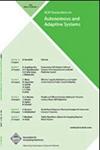Adaptive Composition of Distributed Pervasive Applications in Heterogeneous Environments
IF 2.2
4区 计算机科学
Q3 COMPUTER SCIENCE, ARTIFICIAL INTELLIGENCE
ACM Transactions on Autonomous and Adaptive Systems
Pub Date : 2013-07-01
DOI:10.1145/2491465.2491469
引用次数: 16
Abstract
Complex pervasive applications need to be distributed for two main reasons: due to the typical resource restrictions of mobile devices, and to use local services to interact with the immediate environment. To set up such an application, the distributed components require spontaneous composition. Since dynamics in the environment and device failures may imply the unavailability of components and devices at any time, finding, maintaining, and adapting such a composition is a nontrivial task. Moreover, the speed of such a configuration process directly influences the user since in the event of a configuration, the user has to wait. In this article, we introduce configuration algorithms for homogeneous and heterogeneous environments. We discuss a comprehensive approach to pervasive application configuration that adapts to the characteristics of the environment: It chooses the most efficient configuration method for the given environment to minimize the configuration latency. Moreover, we propose a new scheme for caching and reusing partial application configurations. This scheme reduces the configuration latency even further such that a configuration can be executed without notable disturbance of the user.异构环境中分布式普适应用的自适应组合
需要分发复杂的普及应用程序有两个主要原因:由于移动设备的典型资源限制,以及使用本地服务与直接环境进行交互。要建立这样的应用程序,分布式组件需要自发组合。由于环境中的动态和设备故障可能意味着组件和设备在任何时候都不可用,因此查找、维护和调整这样的组合是一项非常重要的任务。此外,这种配置过程的速度直接影响到用户,因为在配置的情况下,用户必须等待。在本文中,我们将介绍同构和异构环境的配置算法。我们讨论了一种适应环境特征的普及应用程序配置的综合方法:它为给定环境选择最有效的配置方法,以最大限度地减少配置延迟。此外,我们还提出了一种缓存和重用部分应用程序配置的新方案。该方案进一步减少了配置延迟,从而可以在不明显干扰用户的情况下执行配置。
本文章由计算机程序翻译,如有差异,请以英文原文为准。
求助全文
约1分钟内获得全文
求助全文
来源期刊

ACM Transactions on Autonomous and Adaptive Systems
工程技术-计算机:理论方法
CiteScore
4.80
自引率
7.40%
发文量
9
审稿时长
>12 weeks
期刊介绍:
TAAS addresses research on autonomous and adaptive systems being undertaken by an increasingly interdisciplinary research community -- and provides a common platform under which this work can be published and disseminated. TAAS encourages contributions aimed at supporting the understanding, development, and control of such systems and of their behaviors.
TAAS addresses research on autonomous and adaptive systems being undertaken by an increasingly interdisciplinary research community - and provides a common platform under which this work can be published and disseminated. TAAS encourages contributions aimed at supporting the understanding, development, and control of such systems and of their behaviors. Contributions are expected to be based on sound and innovative theoretical models, algorithms, engineering and programming techniques, infrastructures and systems, or technological and application experiences.
 求助内容:
求助内容: 应助结果提醒方式:
应助结果提醒方式:


